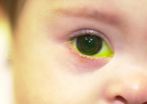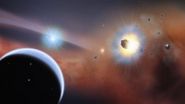(Press-News.org) For adults and children who undergo cataract surgery, implantation of an artificial lens is the standard of care. But a clinical trial suggests that for most infants, surgery followed by the use of contact lenses for several years—and an eventual lens implant—may be the better solution. The trial was funded in part by the National Eye Institute (NEI), a component of the National Institutes of Health.
A cataract is a clouding of the eye's lens, and can be removed through a safe, quick surgical procedure. After cataract removal, most adults and children receive a permanent artificial lens, called an intraocular lens (IOL). This is an option for infants, too, but the trial found that the use of contact lenses is safer than, and just as effective as, an IOL for infants under seven months old. The most recent data from the trial were published today in JAMA Ophthalmology.
"When we began this study, the prevailing theory was that IOLs would be the better option for cataract in infants because they correct vision constantly, while contact lenses can be removed or dislodged from the eye. But our data suggest that if the family can manage it, contact lenses are the better option until the child gets older," said Scott Lambert, M.D., the study's lead investigator and a professor of ophthalmology at Emory University in Atlanta.
Although cataracts are often tied to aging, it's estimated that 1,200-1,600 infants are diagnosed with congenital cataracts (present from birth) each year in the United States. The condition can affect both eyes, but it often affects just one, which is called unilateral cataract. The new study compared the use of IOLs versus the use of contact lenses during infancy for treating congenital unilateral cataract.
In the United States most children with cataract will eventually receive an IOL, but the timing varies, Dr. Lambert said. "I've had patients wait until they were in college whereas others will have it done when they are 5 or 6 years old," he said.
Some prior research suggested that using an IOL to treat cataract during infancy can improve long-term visual outcomes, he said. IOLs can also spare babies—and their parents—the discomfort of daily contact lens changes, and reduce the risk of introducing germs into the eye. On the other hand, the use of IOLs during infancy also has some drawbacks. Surgeons have difficulty judging the right focusing power of the artificial lens for an infant, because it's a time of rapid eye growth. Also, while IOL implants are typically safe and complication-free for adults, they are more likely to cause postoperative problems for infants.
"Cataract surgery and the use of IOLs for infants have become more sophisticated and more widely practiced over time. In this study, the goal was to determine if the beneficial effects of IOLs outweigh their known complications," said Donald Everett, M.A., who is NEI's director of collaborative clinical research.
The Infant Aphakia Treatment Study began in 2004 (aphakia refers to an eye without a lens). The study involved 12 clinical centers, and enrolled infants with a cataract in one eye. Parents visiting these clinics were informed about the study, and about the potential benefits and risks of cataract surgery with and without an IOL. The study ultimately enrolled 114 infants who were between 1 to 6 months old at the time of surgery. By random assignment, about half of the infants received an IOL and the other half received contact lenses. The lenses were soft silicon or hard gas-permeable plastic, and designed to fit small eyes.
The children in the study are now toddlers, and the investigators have examined visual acuity and other outcomes over the long term in both treatment groups. Of note, visual acuity testing in studies like this one presents unique challenges. An adult visual acuity test involves that familiar eye chart with rows of progressively smaller letters, and isn't feasible for a child who hasn't learned the alphabet. The 1-year-olds in the study were tested with Teller acuity cards, which are flash cards imprinted with finer and finer grating patterns—the idea being that a visible pattern will grab a baby's attention while a card that looks blank will not. At 4 1/2 years old, the children were evaluated with the HOTV test, which requires kids to read the letters H-O-T-V or match flash cards containing one of the letters to a response card in their hands.
There were no significant differences in visual acuity between the two groups at age 1, or at age 4 1/2. However, there were more post-surgical complications in the IOL group, which in turn led to more corrective surgeries. The most frequent complication was lens reproliferation—which is when lens cells left behind after cataract surgery migrate into the pupil and interfere with vision. By age 5, lens reproliferation was 10 times more common with IOLs, occurring in 23 (40 percent) of infants in that group, compared to two infants (4 percent) in the contact lens group. This complication and others led to the need for one or more additional eye surgeries among 41 (72 percent) of the infants in the IOL group, and 12 (21 percent) in the contact lens group.
By age 5, nine children in the contact lens group developed minor eye infections that cleared up with antibiotic drops, and in one child, a contact lens broke during wear. None of these issues had permanent effects on vision. Three infants in the contact lens group had IOLs implanted before age 5, because their families had difficulty with day-to-day contact lens changing and maintenance.
"We think that for most infants with unilateral cataract, contact lenses are a better option than an IOL," Dr. Lambert said. "However, in some cases, the parents and their physician may decide that contact lens wear proves to be too challenging, and ultimately not in the child's best interests."
Aside from potential discomfort for the child and anxiety for the parents, there may be less obvious challenges to wearing contact lenses in infancy. Congenital cataract is sometimes hereditary, which means that some parents may have vision problems of their own that would make it difficult to change their kids' contacts. Affordability could also be a challenge for some families. Although health insurance plans generally pay for an IOL, most plans do not pay for contact lenses.
Why not delay both the cataract removal and the IOL until later in childhood? In that scenario, the loss of visual experience in early life could cause some permanent vision loss later, Dr. Lambert said.
INFORMATION:
The study was funded by NEI through grants EY013272, EY013287, and EY006360, and by Research to Prevent Blindness. For more information about the study, see trial NCT00212134 at http://clinicaltrials.gov. For more information about cataract, see http://www.nei.nih.gov/health/cataract/.
Reference:
Lambert, SR et al. for the Infant Aphakia Treatment Study Group. "A Comparison of contact lens and intraocular correction for monocular aphakia during infancy: a randomized clinical trial of HOTV optotype acuity at age 4.5 years and clinical findings at age 5 years." JAMA Ophthalmology, March 2014. DOI: 10.1001/jamaophthalmol.2014.531.
NEI leads the federal government's research on the visual system and eye diseases. NEI supports basic and clinical science programs that result in the development of sight-saving treatments. For more information, visit http://www.nei.nih.gov.
About the National Institutes of Health (NIH): NIH, the nation's medical research agency, includes 27 Institutes and Centers and is a component of the U.S. Department of Health and Human Services. NIH is the primary federal agency conducting and supporting basic, clinical, and translational medical research, and is investigating the causes, treatments, and cures for both common and rare diseases. For more information about NIH and its programs, visit http://www.nih.gov/.
Contacts better than permanent lenses for babies after cataract surgery
Permanent lenses lead to more repeat eye surgeries, NIH study finds
2014-03-06
ELSE PRESS RELEASES FROM THIS DATE:
NASA's Hubble Telescope witnesses asteroid's mysterious disintegration
2014-03-06
NASA's Hubble Space Telescope has recorded the never-before-seen break-up of an asteroid into as many as 10 smaller pieces.
Fragile comets, comprised of ice and dust, have been seen falling apart as they near the sun, but nothing like this has ever before been observed in the asteroid belt.
"This is a rock, and seeing it fall apart before our eyes is pretty amazing," said David Jewitt of the University of California at Los Angeles, who led the astronomical forensics investigation.
The crumbling asteroid, designated P/2013 R3, was first noticed as an unusual, fuzzy-looking ...
Nearby star's icy debris suggests 'shepherd' planet
2014-03-06
VIDEO:
NASA Goddard's Aki Roberge explains how observations with the Atacama Large Millimeter/submillimeter Array in Chile tell us about poison gas, comet swarms and a hypothetical planet around Beta Pictoris....
Click here for more information.
An international team of astronomers exploring the disk of gas and dust around a nearby star have uncovered a compact cloud of poisonous gas formed by ongoing rapid-fire collisions among a swarm of icy, comet-like bodies. The researchers ...
Study provides new information about the sea turtle 'lost years'
2014-03-06
MIAMI – A new study satellite tracked 17 young loggerhead turtles in the Atlantic Ocean to better understand sea turtle nursery grounds and early habitat use during the 'lost years.' The study, conducted by a collaborative research team, including scientists from the University of Miami (UM) Rosenstiel School of Marine and Atmospheric Science, was the first long-term satellite tracking study of young turtles at sea.
"This is the first time we were able to show the maiden voyage of young turtles after they left the beach," said Rosenstiel School scientist Jiangang Luo ...
$4M grant to improve asthma care for So Cal Latino youth
2014-03-06
SAN DIEGO, Calif. (March 6, 2014)—A team led by researchers at San Diego State University has been awarded $4 million to enhance asthma education and treatment strategies in California's Imperial Valley, where children are twice as likely as the national average to suffer from asthma.
The grant will allow researchers to better understand the specific asthma needs of Imperial Valley's largely Latino/Latina population, as well as develop more effective approaches to treatment for families, communities, and physicians.
Approximately 4.5 million African-Americans and 3.6 ...
Fertilizer in small doses yields higher returns for less money
2014-03-06
URBANA, Ill. - Crop yields in the fragile semi-arid areas of Zimbabwe have been declining over time due to a decline in soil fertility resulting from mono-cropping, lack of fertilizer, and other factors. In collaboration with the International Crops Research Institute for the Semi-Arid Tropics (ICRISAT), University of Illinois researchers evaluated the use of a precision farming technique called "microdosing," its effect on food security, and its ability to improve yield at a low cost to farmers.
"Microdosing involves applying a small, affordable amount of fertilizer ...
Story Tips from the Department of Energy's Oak Ridge National Laboratory, March 2014
2014-03-06
MATERIALS – Lighter, stronger engines . . .
Engines could become lighter and more efficient because of a research project that combines the talents and resources of the Chrysler Group, Nemak S.A. of Mexico and Oak Ridge National Laboratory. The goal of the four-year $5.5 million cooperative research and development agreement is to develop an advanced cast aluminum alloy for next-generation higher efficiency engines. In addition to being lighter, the new alloy for cylinder heads would be stronger and capable of sustaining the higher temperatures and pressures of engines ...
Preschoolers can outsmart college students at figuring out gizmos
2014-03-06
Preschoolers can be smarter than college students at figuring out how unusual toys and gadgets work because they're more flexible and less biased than adults in their ideas about cause and effect, according to new research from the University of California, Berkeley, and the University of Edinburgh.
The findings suggest that technology and innovation can benefit from the exploratory learning and probabilistic reasoning skills that come naturally to young children, many of whom are learning to use smartphones even before they can tie their shoelaces. The findings also ...
Kawasaki disease and pregnant women
2014-03-06
In the first study of its type, researchers at the University of California, San Diego School of Medicine have looked at the health threat to pregnant women with a history of Kawasaki disease (KD), concluding that the risks are low with informed management and care.
The findings are published in the March 6, 2014 online edition of the British Journal of Obstetrics and Gynaecology.
KD is a childhood condition affecting the coronary arteries. It is the most common cause of acquired heart disease in children. First recognized in Japan following World War II, KD diagnoses ...
Early detection helps manage a chronic graft-vs.-host disease complication
2014-03-06
SEATTLE – A simple questionnaire that rates breathing difficulties on a scale of 0 to 3 predicts survival in chronic graft-vs.-host disease, according to a study published in the March issue of Biology of Blood and Marrow Transplantation.
And although a poor score means a higher risk of death, asking a simple question that can spot lung involvement early means that patients can begin treatments to reduce or manage symptoms, said senior author Stephanie Lee, M.D., M.P.H., research director of Fred Hutchinson Cancer Research Center's Long-Term Follow-Up Program, member ...
Crashing comets explain surprise gas clump around young star
2014-03-06
Beta Pictoris, a nearby star easily visible to the naked eye in the southern sky, is already hailed as the archetypal young planetary system. It is known to harbour a planet that orbits some 1.2 billion kilometres from the star, and it was one of the first stars found to be surrounded by a large disc of dusty debris [1].
New observations from ALMA now show that the disc is permeated by carbon monoxide gas.
Paradoxically the presence of carbon monoxide, which is so harmful to humans on Earth, could indicate that the Beta Pictoris planetary system may eventually become ...
LAST 30 PRESS RELEASES:
Decoupling the HOR enhancement on PtRu: Dynamically matching interfacial water to reaction coordinates
Sulfur isn’t poisonous when it synergistically acts with phosphine in olefins hydroformylation
URI researchers uncover molecular mechanisms behind speciation in corals
Chitin based carbon aerogel offers a cleaner way to store thermal energy
Tracing hidden sources of nitrate pollution in rapidly changing rural urban landscapes
Viruses on plastic pollution may quietly accelerate the spread of antibiotic resistance
Three UH Rainbow Babies & Children’s faculty elected to prestigious American Pediatric Society
Tunnel resilience models unveiled to aid post-earthquake recovery
Satellite communication systems: the future of 5G/6G connectivity
Space computing power networks: a new frontier for satellite technologies
Experiments advance potential of protein that makes hydrogen sulfide as a therapeutic target for Alzheimer’s disease
Examining private equity’s role in fertility care
Current Molecular Pharmacology achieves a landmark: real-time CiteScore advances to 7.2
Skeletal muscle epigenetic clocks developed using postmortem tissue from an Asian population
Estimating unemployment rates with social media data
Climate policies can backfire by eroding “green” values, study finds
Too much screen time too soon? A*STAR study links infant screen exposure to brain changes and teen anxiety
Global psychiatry mourns Professor Dan Stein, visionary who transformed mental health science across Africa and beyond
KIST develops eco-friendly palladium recovery technology to safeguard resource security
Statins significantly reduce mortality risk for adults with diabetes, regardless of cardiovascular risk
Brain immune cells may drive more damage in females than males with Alzheimer’s
Evidence-based recommendations empower clinicians to manage epilepsy in pregnancy
Fungus turns bark beetles’ defenses against them
There are new antivirals being tested for herpesviruses. Scientists now know how they work
CDI scientist, colleagues author review of global burden of fungus Candida auris
How does stroke influence speech comprehension?
B cells transiently unlock their plasticity, risking lymphoma development
Advanced AI dodel predicts spoken language outcomes in deaf children after cochlear implants
Multimodal imaging-based cerebral blood flow prediction model development in simulated microgravity
Accelerated streaming subgraph matching framework is faster, more robust, and scalable
[Press-News.org] Contacts better than permanent lenses for babies after cataract surgeryPermanent lenses lead to more repeat eye surgeries, NIH study finds






